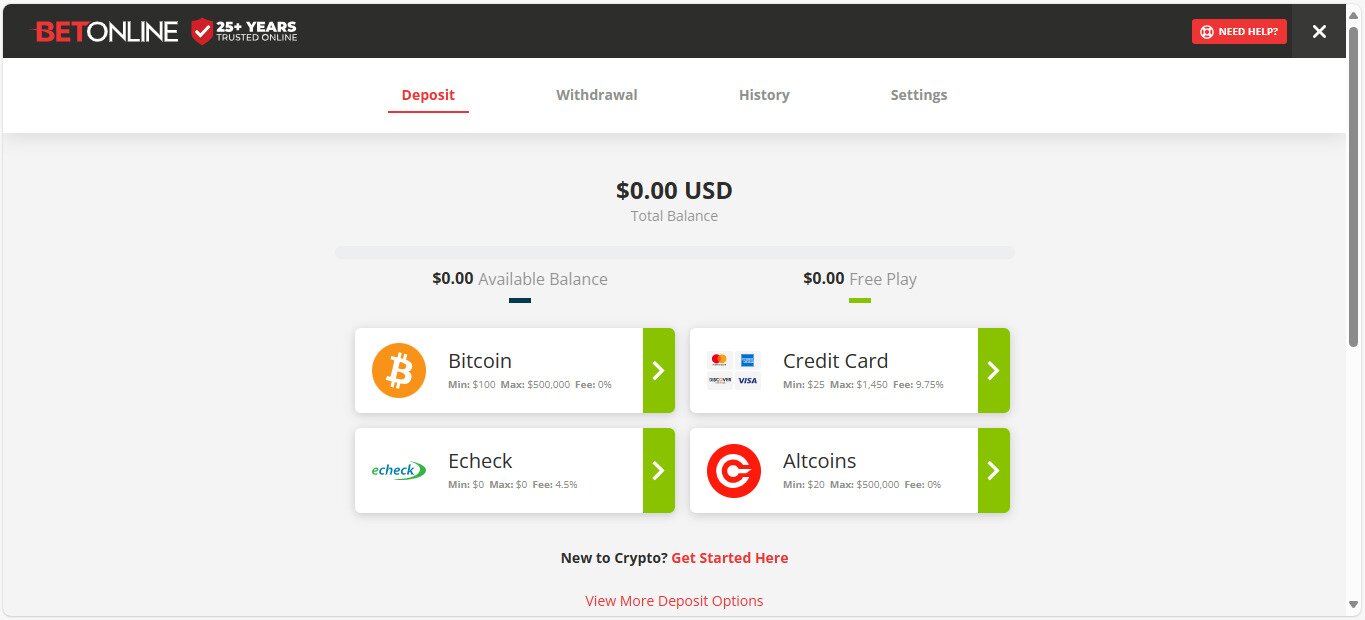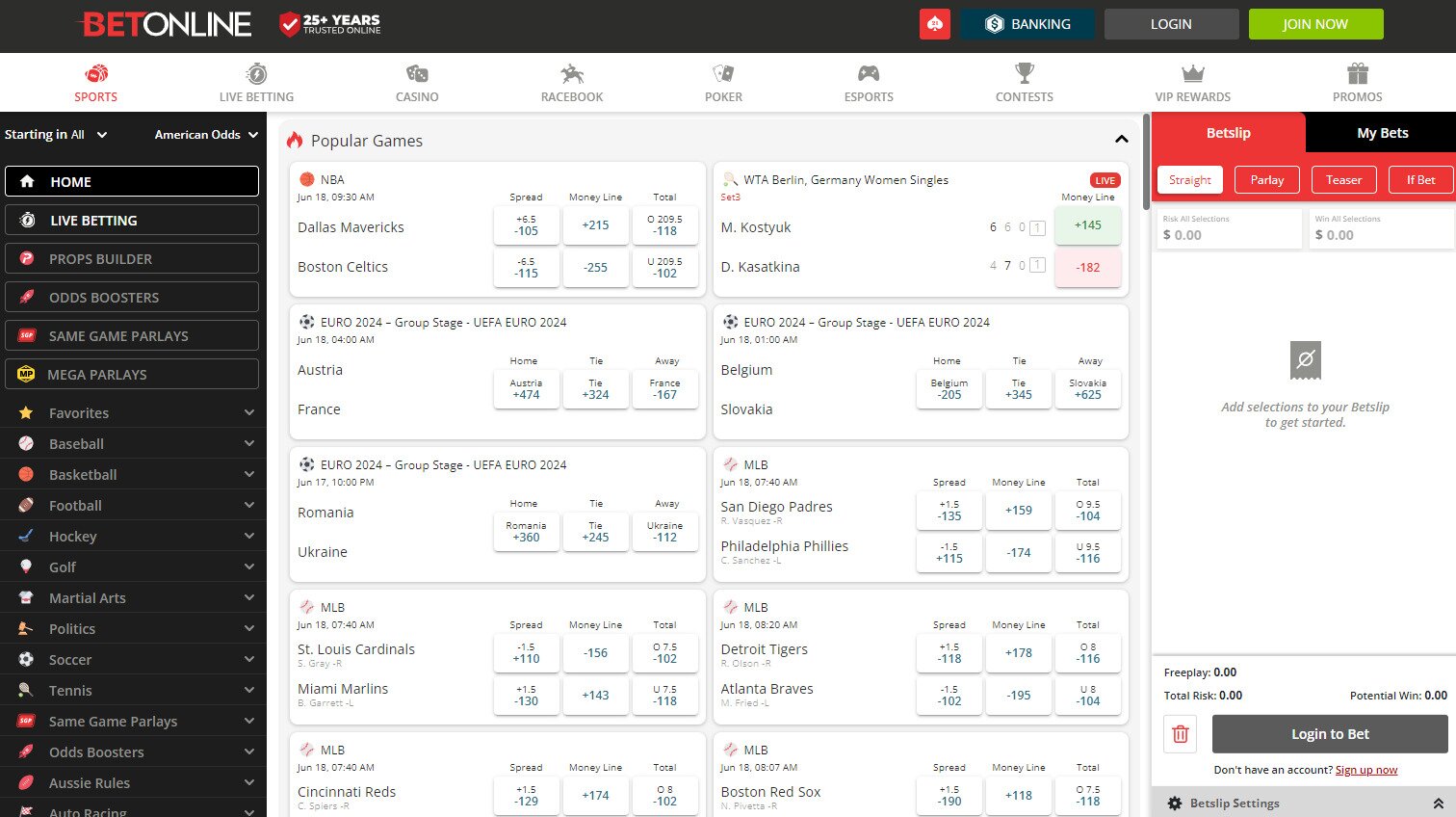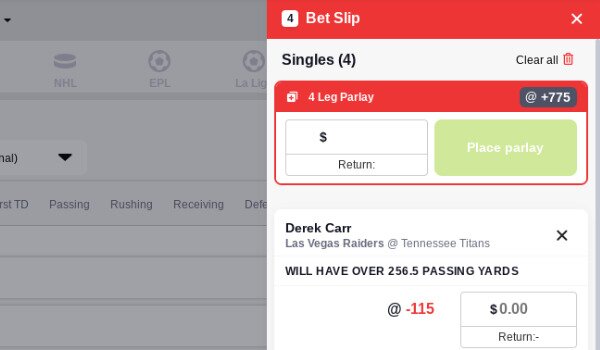- Online Casinos
- Online Betting Sites
- How to Deposit
- Gambling Site Reviews
- Gambling in My Location
 USA
USA
- Alabama
- Alaska
- Arkansas
- Arizona
- California
- Colorado
- Connecticut
- Delaware
- Florida
- Georgia
- Hawaii
- Idaho
- Illinois
- Indiana
- Iowa
- Kansas
- Kentucky
- Louisiana
- Maine
- Maryland
- Massachusetts
- Michigan
- Minnesota
- Mississippi
- Missouri
- Montana
- Nebraska
- Nevada
- New Hampshire
- New Mexico
- New York
- North Carolina
- North Dakota
- Ohio
- Oklahoma
- Oregon
- Pennsylvania
- Rhode Island
- South Carolina
- South Dakota
- Tennessee
- Texas
- Utah
- Vermont
- Virginia
- Washington
- Wisconsin
- Wyoming
 Canada
Canada Australia
Australia UK
UK
- Casino of the Month
Best Tennis Betting Sites Online
Tennis betting sites offer endless opportunities with year-round action. There are literally thousands of matches to bet on every month, including everything from career-defining Grand Slam duels to exhibition matches.
The best tennis betting sites let you bet on anything from match-winner markets to props, offering attractive odds on all wagers. So, how do you find such sites? With the help of our guide to the best sportsbooks for tennis – learn about the best sites, top bonuses, and more.
Disclosure: At GamblingSites.com, our mission is to connect you with the best gambling sites and informational resources available. If you click one of the links on our site, we may earn a commission payment at no extra charge to you.
This score goes to the highest rated sites by experts. Only sites that hold an expert rating of above 85% are given this status.
A green Jackpot Certified score is awarded when at least 60% of expert reviews are positive.
A red Bust score is displayed when less than 60% of expert reviews are positive.
A grayed-out gem means there are not enough expert ratings to produce a score. The gambling site could be new.
A green Jackpot Certified score means that at least 60% of player reviews are positive.
A red Bust score means that less that 59% or less of player reviews are positive.
A grayed-out face means there are not enough player reviews to produce a score.
Best Tennis Betting Sites
The following are our most recommended tennis betting sites. Each one is sorted by what it does best, so you can find the sportsbook that matches what you want.
- BetOnline – Best Overall Tennis Betting Site
- BetUS – Best Sportsbook for Tennis Odds
- BetUS – Top Tennis Sportsbook for Bonuses
- Bet365 – Best Live Tennis Betting Site
- 888 – Top Tennis Betting App
BetOnline Best Overall Tennis Betting Site
With a BetOnline account, you can bet on literally hundreds of tennis tournaments throughout the year, from Grand Slams to ITF Senior Tours. You can bet on tennis before the match but also in-play. It’s also possible to bet on tennis specials like the number of Grand Slam wins by Emma Raducanu.
BetOnline is also great for its bonuses, many of which can be used for tennis betting. One such deal is the $250 free bet for new players – just make a deposit with bank cards or one of the 16 supported cryptos and you’ll get the bonus.
-

-
71%
68%
- Bonus: 50% up to $250 in bets + 100 free spins
- Visit Site Read Review
This score goes to the highest rated sites by experts. Only sites that hold an expert rating of above 85% are given this status.
A green Jackpot Certified score is awarded when at least 60% of expert reviews are positive.
A red Bust score is displayed when less than 60% of expert reviews are positive.
A grayed-out gem means there are not enough expert ratings to produce a score. The gambling site could be new.
A green Jackpot Certified score means that at least 60% of player reviews are positive.
A red Bust score means that less that 59% or less of player reviews are positive.
A grayed-out face means there are not enough player reviews to produce a score.
BetUS Best Sportsbook for Tennis Odds
BetUS is the best sportsbook for tennis if attractive betting odds are on your mind. We analyzed the BetUS tennis odds and concluded that its profit margin on ATP events is around 5%. In comparison, many other tennis betting sites keep it over 6%.
This tennis sportsbook also offers competitive odds for futures. For example, the No. 1 favorite to win next year’s US Open is priced at +200; at many other sites, their odds are somewhere in the ballpark of +130.
On top of everything, BetUS also has the Odds Boost feature. It’s exactly as it sounds like – odds on some tennis bets are boosted by the sportsbook to increase your potential payout.
-

-
80%
72%
- Bonus: 125% up to $2,500
- Visit Site Read Review
This score goes to the highest rated sites by experts. Only sites that hold an expert rating of above 85% are given this status.
A green Jackpot Certified score is awarded when at least 60% of expert reviews are positive.
A red Bust score is displayed when less than 60% of expert reviews are positive.
A grayed-out gem means there are not enough expert ratings to produce a score. The gambling site could be new.
A green Jackpot Certified score means that at least 60% of player reviews are positive.
A red Bust score means that less that 59% or less of player reviews are positive.
A grayed-out face means there are not enough player reviews to produce a score.
BetUS Top Tennis Sportsbook for Bonuses
The main reason why we think Bovada is the best choice for tennis bettors looking for good offers is that its welcome bonus comes with 5x wagering. The best thing is that you can fulfill the playthrough requirement by betting on any tennis event from Bovada’s offer.
The welcome bonus is lucrative as well – you will get a 75% match (up to $750) for crypto deposits or 50% (up to $250) for bank card payments.
In addition to the bonus for new players, Bovada also has a parlay booster for tennis matches, tennis contests, and other promos.
-

-
80%
72%
- Bonus: 125% up to $2,500
- Visit Site Read Review
This score goes to the highest rated sites by experts. Only sites that hold an expert rating of above 85% are given this status.
A green Jackpot Certified score is awarded when at least 60% of expert reviews are positive.
A red Bust score is displayed when less than 60% of expert reviews are positive.
A grayed-out gem means there are not enough expert ratings to produce a score. The gambling site could be new.
A green Jackpot Certified score means that at least 60% of player reviews are positive.
A red Bust score means that less that 59% or less of player reviews are positive.
A grayed-out face means there are not enough player reviews to produce a score.
Bet365 Best Live Tennis Betting Site
Bet365 is famous for its live sportsbook, covering dozens of tennis matches daily. Some of the in-play betting options available at this online bookmaker include the next point/game/set winner, over/under markets, etc. Not only can you bet on live events, but you can also cash out of those bets early.
Bet365 will also provide you with live stats and other useful information that can help you make the right betting choice. And we still haven’t told you the best thing – there’s also a live streaming option.
Dozens of tennis matches are live-streamed on Bet365 daily, completely free of charge. The only condition is that you have at least a couple of dollars in your account.
-

-
89%
75%
- Bonus: Bet $10 receive $50 in bonus bets
- Visit Site Read Review
This score goes to the highest rated sites by experts. Only sites that hold an expert rating of above 85% are given this status.
A green Jackpot Certified score is awarded when at least 60% of expert reviews are positive.
A red Bust score is displayed when less than 60% of expert reviews are positive.
A grayed-out gem means there are not enough expert ratings to produce a score. The gambling site could be new.
A green Jackpot Certified score means that at least 60% of player reviews are positive.
A red Bust score means that less that 59% or less of player reviews are positive.
A grayed-out face means there are not enough player reviews to produce a score.
888 Top Tennis Betting App
We consider 888 Sports the best tennis sportsbook for mobile users. First, it’s because its website is mobile-responsive, thus it works great on smartphones and tablets.
But that’s not all – this is one of the tennis betting sites that also have a native app. There’s one available on Google Play (for Androids), as well as one on App Store (for iPhones and iPads) – there are links to both on the 888 Sports website.
The apps are under 80 MB, meaning that you can download them quickly. They’re secure, fast, and full of useful options that will make mobile betting easy for you.
-

-
71%
59%
- Bonus: 100% up to $250
- Visit Site Read Review
This score goes to the highest rated sites by experts. Only sites that hold an expert rating of above 85% are given this status.
A green Jackpot Certified score is awarded when at least 60% of expert reviews are positive.
A red Bust score is displayed when less than 60% of expert reviews are positive.
A grayed-out gem means there are not enough expert ratings to produce a score. The gambling site could be new.
A green Jackpot Certified score means that at least 60% of player reviews are positive.
A red Bust score means that less that 59% or less of player reviews are positive.
A grayed-out face means there are not enough player reviews to produce a score.
How We Rate the Best Tennis Betting Websites
If you’re wondering how we rank sports betting sites, it’s by taking into account the Jackpot Meter ratings. We then compare the final score with our own findings about the sportsbook, making sure that it excels in all of the following:
- Competitive Odds – Winning big starts with great odds, so we prioritize sites offering the best prices for tennis betting.
- Tennis Markets – We favor sportsbooks with diverse tennis betting options, including props, futures, and specials.
- Live Betting – Top online tennis betting sites provide in-play betting and even live streaming of certain matches.
- Tennis Bonuses – The best bonuses can be used for tennis betting and come with reasonable wagering requirements.Safe & Secure – On top of tennis-specific factors, we also pay attention to security features, operating licenses, and reliable payment methods.
The Jackpot Meter

The Jackpot Meter is our exclusive tool that blends expert analysis with real user reviews to deliver a unique score for tennis betting sites.
It’s a no-nonsense system – platforms are either Jackpot Certified or Bust. This ensures you’re betting only on trusted, high-quality sites that meet our strict criteria for odds, markets, and bonuses.
Comparing the Best Online Tennis Sportsbooks
| Tennis Sportsbook | Min. Deposit | Welcome Bonus | Rollover Requirement | Live Tennis Betting | Tennis Contests |
|---|---|---|---|---|---|
| BetOnline | $10 | 50% up to $250 | No Rollover | Yes | Yes |
| BetUS | $10 | 150% up to $2,000 | 30x | Yes | Yes |
| Bovada | $10 | 75% up to $750 | 5x | Yes | Yes |
| Bet365 | $10 | 500% up to $50 | No Rollover | Yes | No |
| 888 Sport | $10 | 100% up to $250 | 40x | Yes | No |
How to Bet on Tennis Online
Eager to serve up some tennis bets? If so, here’s a step-by-step guide on how to bet on tennis online:

Register an account at one (or more) sports betting sites. Let’s say you wish to do it at BetOnline; you just need to visit the site, hit the JOIN button, and follow the on-screen instructions.

Pick one of the accepted deposit methods – in the case of BetOnline, there are 24 options to choose from – and make your first deposit. If needed, enter the bonus code or choose the right deal from the list of available bonuses and promotions.

Go to the online sportsbook section and look for tennis on the sports menu. Explore available bets for both pre-game and live betting markets until you find those worth betting on. By this, we mean tennis bets that are likely to win and come with attractive odds.

Decide if you’re going to go with a straight bet or combine several tennis bets into a parlay. Enter the amount you wish to wager and confirm your bet. When done, all that’s left is to wait and see if your player will win.
Online Tennis Betting Tips
While luck might occasionally hit the baseline, informed decisions can help you ace your tennis bets. Do your due diligence by analyzing key player stats – performance on a certain type of surface, their record against top 10 opponents, etc.
In the next section, we’ll explain how it’s done, sharing some useful tennis betting tips along the way.
Surface Matters: Hardcourt vs. Clay vs. Grass
Legendary Spanish player Rafael Nadal wasn’t nicknamed King of Clay by accident – his win percentage on this surface is 90.50%, which is the highest in the history of tennis. On grass, however, his win percentage was 78.35%, showing that different players prefer different courts.
So, before you bet on someone, make sure to check their stats on the surface on which their next match is supposed to be played. Luckily for you, some tennis betting sites have this data at the players’ disposal. If not, you can always look for information on the official sites of the ATP and WTA Tour.
Performance Trends: Spotting the Momentum
Players can elevate or decline in form, and spotting these shifts is essential. If someone’s won their last couple of matches, the chances are they’ll keep on winning. But nothing lasts forever, so betting against someone who’s on a roll could be a smart tennis betting strategy.
This goes especially if it’s late in the season when everyone’s in need of a rest. In 2024, for example, Novak Djokovic won 37 matches while losing only nine. However, two of those losses happened in his final three matches of the year.
Money & Fame: Factors Fueling Players' Motivation
Jannik Sinner and Aryna Sabalenka each added $3.6 million to their bank account in 2024 after winning the men’s and women’s tournaments at the US Open. With so much money at stake, everyone’s ready to give their maximum. This explains why majors like the US Open are almost always won by top favorites.
But it’s not just about money; it’s also about status. Novak Djokovic has been a millionaire since his teens, but he hasn’t lost any motivation, with his goal being to win as many Grand Slam tournaments as possible.
Popular Tennis Bet Types
There are some tennis betting sites out there that offer 100+ markets for big tennis matches, such as the final of a major tournament. However, for regular matches, the offer is usually concentrated on the most popular tennis bets – the match-winner, handicaps, and totals – all of which we’ll explain in more detail below.
- Match-Winner – Also known as the moneyline bet, the match-winner refers to betting on the outcome of a single match. With this bet type, odds are often lopsided, with one player being a huge favorite. In Jannick Sinner’s first match of the 2024 US Open, top offshore sportsbooks were giving -10000 odds on him winning.
- Handicap – To make betting on one-sided matches more exciting, bookmakers come up with handicaps. How these bets work is that the favorite is given a “handicap” in the form of a couple of games, which they need to fulfill for the bet to win.
- Totals – How many games or sets will a tennis match see in total? The oddsmakers will come up with a margin. It’s up to you to guess whether the total number will be over or under.
- Outrights – in addition to match-based wagers, some tennis betting sites also offer odds for outrights, a.k.a. futures. Basically, you get to put your money on who’s going to win the tournament in question.
Biggest Tennis Events to Bet On
| Tennis Event | Location | Date | Notes |
|---|---|---|---|
| Australian Open | Melbourne, Australia | January 12 – January 26, 2025 | The first major tournament of the year, usually starting in the second half of January. |
| French Open | Paris, France | May 25 – June 8, 2025 | The only Grand Slam tournament played on clay. |
| Wimbledon | Wimbledon, United Kingdom | June 30 – July 13, 2025 | The grass-court major is the oldest tennis tournament, having been around since 1877. |
| US Open | New York City, United States | August 25 – September 7, 2025 | The final Grand Slam of the year, as well as the one with the biggest prize pool. |
| Olympic Tennis | Los Angeles, United States | July 14 – July 30, 2028 | Players don’t win ATP/WTA points; instead, they compete for personal glory and pride of their nation. |
| Davies Cup | Various cities around the world | January 31 – November 25, 2025 | International tennis league in which national teams compete with each other. |
| Laver Cup | San Francisco, United States | September 19 – 21, 2025 | Europe vs. USA tournament, with two teams made up of the best players from each continent. |
Gamble on Tennis Online Responsibly
Tennis betting is meant to be fun, so if you feel it’s getting out of hand, it’s time to take a break. To help with that, many sportsbooks provide tools like cool-off periods, self-exclusion, deposit limits, betting caps, etc.
To learn about other ways to ensure responsible betting, check out our responsible gambling page or visit some non-profits like Gamble Aware.
Serve Some Aces at Top Tennis Betting Sites
To wrap things up, BetOnline is our top pick for tennis betting. It ticks all the boxes needed to be called the best – a huge coverage of tennis matches, plenty of interesting betting options, etc.
If competitive odds are your priority, BetUS is a great alternative, while Bovada stands out for its easy-to-clear bonuses, which can be used for tennis betting.
Bet on tennis at a Jackpot Certified website and you won’t make a bad choice. Whichever of our recommended sports betting sites you pick, make sure you do your research before placing bets. Above all, make sure you gamble responsibly!
This score goes to the highest rated sites by experts. Only sites that hold an expert rating of above 85% are given this status.
A green Jackpot Certified score is awarded when at least 60% of expert reviews are positive.
A red Bust score is displayed when less than 60% of expert reviews are positive.
A grayed-out gem means there are not enough expert ratings to produce a score. The gambling site could be new.
A green Jackpot Certified score means that at least 60% of player reviews are positive.
A red Bust score means that less that 59% or less of player reviews are positive.
A grayed-out face means there are not enough player reviews to produce a score.

